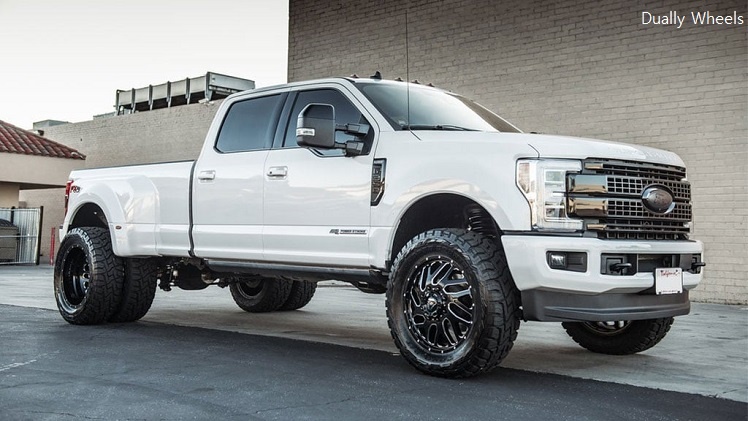Have you ever used Dually Wheels?
If yes, you’ll surely understand just how much confusion exists among those who rely on these rims for mostly commercial purposes and who use them on a regular basis.
Of course, heavy truck drivers don’t usually have these misconceptions. But what happens if you are using Dually rims for the first time in your life?
One of the biggest questions is this: should dually tires touch each other? If not, how much space should separate these tires?
It should be noted here, as an aside, that the tires used in Dually Wheels are hardly the same as the regular heavyweight and high-riding tires that can traverse thousands of miles every year without too much visible damage. Also, dually tires are most often a lot larger than the usual models we use on a daily basis.
Here are some FAQs broken down just for you.
Dually tires for trucks: a few pointers
There appears to be a lot of confusion circulating around the tires that are used in Dually Wheels.
>The biggest and commonest one is this: how much space should there be between these tires?
The simple answer is this: there should not be any space! When the tires are mounted, they should not touch at all. Around the world, tire professionals believe that the minimum gap between these heavyweight (quite literally) tires is 2 inches. No more.
If you see that the tires are touching and the gap is absent, you will have to trust the technicians on doing a better job next time. Also, you must ensure that they are remounted.
For that matter, no tire aboard any vehicle- – commercial or not – should touch one another. It erodes them a lot quicker, eats away at your mileage and guzzle fuel, and give you a pretty hard time controlling them on even the smoothest of surfaces.
Okay. Why do the tires often touch?
There are several reasons why Dually tires touch one another even if that little contact is as small as a single piece of chewing gum!
We spoke with the technicians at AudioCity USA, one of our favorite retailers of rims and tires in California. This agency has been in this business for around 35 years and we swear by their professional advice.
Here’s what they said.
- Sizes are all wrong: If you are using wheels that are much too large for your trucks, or tires that are gigantic and should be given a wide berth, there are chances that there will be contact at some points.
If that happens, your expensive Dually Wheels will also be afflicted. Please remember that all Dually rims and tires are a lot more expensive than the ordinary ones. Even the oversized ATV tires don’t come close!
For best results, refer to the rim manufacturer’s manual. You will find several excellent suggestions mentioned. From RBP to Ion to Fuel and Vision and American Racing Wheels, rely only on trusted brands like these.
- Tires not balanced properly: The sole purpose of tire balancing is to ensure that they run straight and true. But if the balancing process has not been done right, there will definitely be problems which might not be apparent initially but will almost certainly be a major headache a few miles later!
Imbalanced tires not only reduce the life of each tube but also cause a number of accidents on the roads. More so when you are driving a massive tank-like truck that’s probably hauling a ton of goods!
Properly balanced tires do not brush against one another and help you have a glitch-free and a fairly snappy drive. They won’t touch at all!
Don’t take any risks; talk to your technician immediately.
- Ball joints are defaced beyond repair: Ball joints that connect the suspension to the steering uprights (or knuckles) might often be damaged enough to be completely ineffective. It affects the connection of the tires and often leads to misalignments. The best way ahead is to replace the joints entirely as they cannot ever be repaired.
Replacing these joints are a lot easier and cheaper than having to frequently replace Dually Wheels and tires too!
- Suspension issues: The suspension system on every vehicle is one of the most challenging and complicated ones. The system consists of several parts and each of them has a role to play. If you find that there is a general discomfort in controlling the vehicle, a vibration that starts from the steering column and then spreads across the floorboards, or everyone in the vehicle has a very rough ride, it is time to get the suspension checked out thoroughly.
Depending on the problem, solutions are applied. Note that suspension parts always require replacements without exception.
I see. How do I keep my Dually Wheels and tires in good shape?
These are some points that you can and should follow.
- Ensure that the dually tires are rotated once every 10,000 miles or so. Ideally, they must also be balanced using advanced tools like Hunter’s in the same session.
- Balancing the wheels and tires in a dually setup is different because there are effectively 2 sets of each. Trust only established repair outlets.
- Ask your technicians to use a ‘dual spacing tool’ and ensure that there is nothing awry.
- Finally, ensure that the lug nuts and the braking mechanism are both in ship shape.
Finally…
Note that these tips apply to the ‘Big 3’ of Dually trucks: the RAM and the GMC Sierra 3500HD and the Ford-F350 Super Duty.
Buy only branded Dually Wheels regardless of whether you are driving a Sierra or a 5th-Gen Silverado or a relatively obscure vehicle.

